Operations Management Analysis: Nissan's Competitive Advantage Report
VerifiedAdded on 2022/09/24
|9
|1577
|21
Report
AI Summary
This report provides an in-depth analysis of Nissan's operations management practices. It begins by evaluating how Nissan utilizes operations management functions to produce goods and generate value for its customers, supported by examples and insights into the company's competitive advantages. The report then delves into a comparison and contrast of Nissan's service and manufacturing operations, highlighting their similarities, differences, and respective contributions to customer value. Furthermore, it examines the application of the Critical Path Method (CPM) and Program Evaluation and Review Technique (PERT) within Nissan's operations, particularly in the context of contingency planning and project management. The report also outlines the steps involved in developing a forecasting system, illustrating its practical use within the company. Finally, the analysis extends to supply chain risk management, exploring the factors that contribute to effective supply chain management and risk mitigation strategies adopted by Nissan, particularly in response to significant events like the 2011 earthquake.
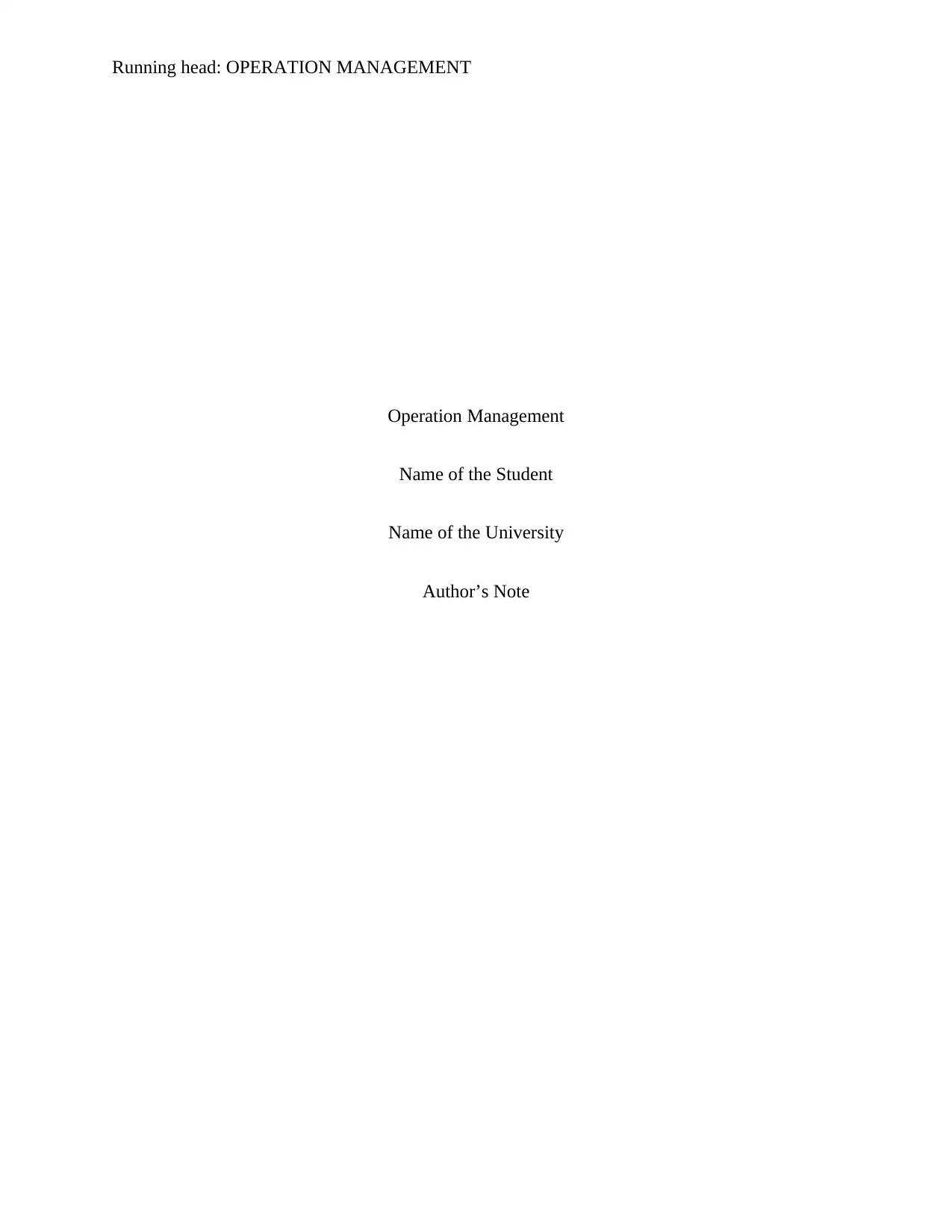
Running head: OPERATION MANAGEMENT
Operation Management
Name of the Student
Name of the University
Author’s Note
Operation Management
Name of the Student
Name of the University
Author’s Note
Paraphrase This Document
Need a fresh take? Get an instant paraphrase of this document with our AI Paraphraser
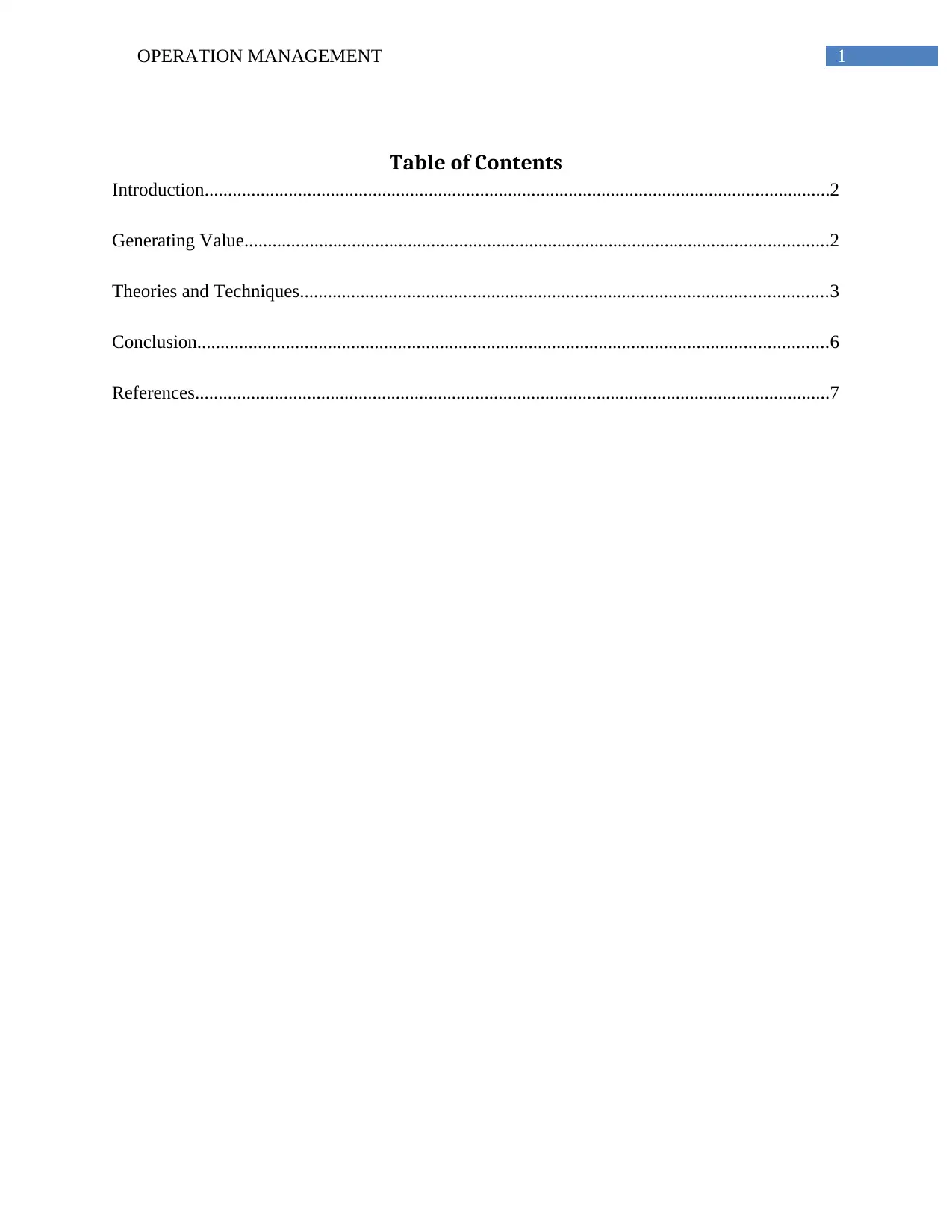
1OPERATION MANAGEMENT
Table of Contents
Introduction......................................................................................................................................2
Generating Value.............................................................................................................................2
Theories and Techniques.................................................................................................................3
Conclusion.......................................................................................................................................6
References........................................................................................................................................7
Table of Contents
Introduction......................................................................................................................................2
Generating Value.............................................................................................................................2
Theories and Techniques.................................................................................................................3
Conclusion.......................................................................................................................................6
References........................................................................................................................................7
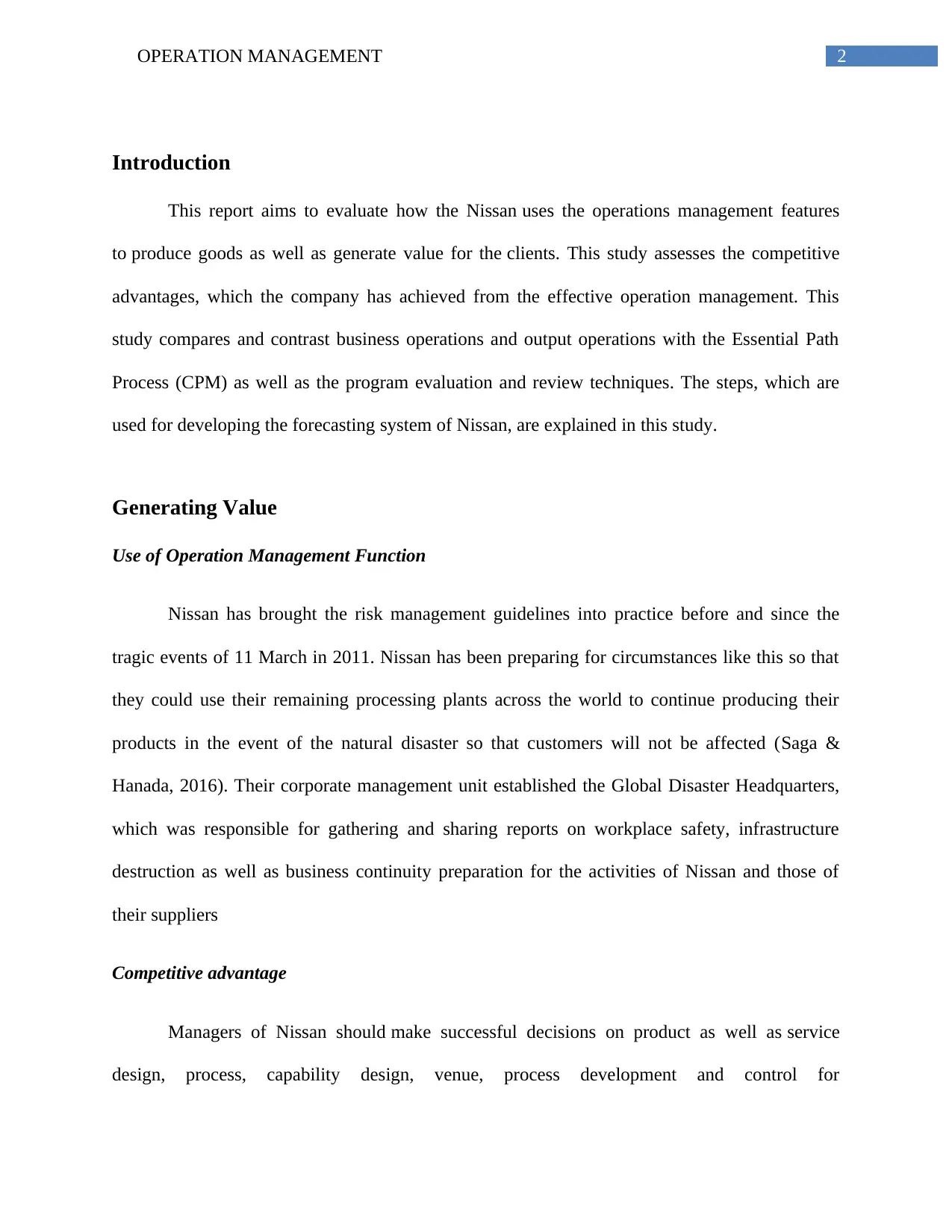
2OPERATION MANAGEMENT
Introduction
This report aims to evaluate how the Nissan uses the operations management features
to produce goods as well as generate value for the clients. This study assesses the competitive
advantages, which the company has achieved from the effective operation management. This
study compares and contrast business operations and output operations with the Essential Path
Process (CPM) as well as the program evaluation and review techniques. The steps, which are
used for developing the forecasting system of Nissan, are explained in this study.
Generating Value
Use of Operation Management Function
Nissan has brought the risk management guidelines into practice before and since the
tragic events of 11 March in 2011. Nissan has been preparing for circumstances like this so that
they could use their remaining processing plants across the world to continue producing their
products in the event of the natural disaster so that customers will not be affected (Saga &
Hanada, 2016). Their corporate management unit established the Global Disaster Headquarters,
which was responsible for gathering and sharing reports on workplace safety, infrastructure
destruction as well as business continuity preparation for the activities of Nissan and those of
their suppliers
Competitive advantage
Managers of Nissan should make successful decisions on product as well as service
design, process, capability design, venue, process development and control for
Introduction
This report aims to evaluate how the Nissan uses the operations management features
to produce goods as well as generate value for the clients. This study assesses the competitive
advantages, which the company has achieved from the effective operation management. This
study compares and contrast business operations and output operations with the Essential Path
Process (CPM) as well as the program evaluation and review techniques. The steps, which are
used for developing the forecasting system of Nissan, are explained in this study.
Generating Value
Use of Operation Management Function
Nissan has brought the risk management guidelines into practice before and since the
tragic events of 11 March in 2011. Nissan has been preparing for circumstances like this so that
they could use their remaining processing plants across the world to continue producing their
products in the event of the natural disaster so that customers will not be affected (Saga &
Hanada, 2016). Their corporate management unit established the Global Disaster Headquarters,
which was responsible for gathering and sharing reports on workplace safety, infrastructure
destruction as well as business continuity preparation for the activities of Nissan and those of
their suppliers
Competitive advantage
Managers of Nissan should make successful decisions on product as well as service
design, process, capability design, venue, process development and control for
⊘ This is a preview!⊘
Do you want full access?
Subscribe today to unlock all pages.

Trusted by 1+ million students worldwide
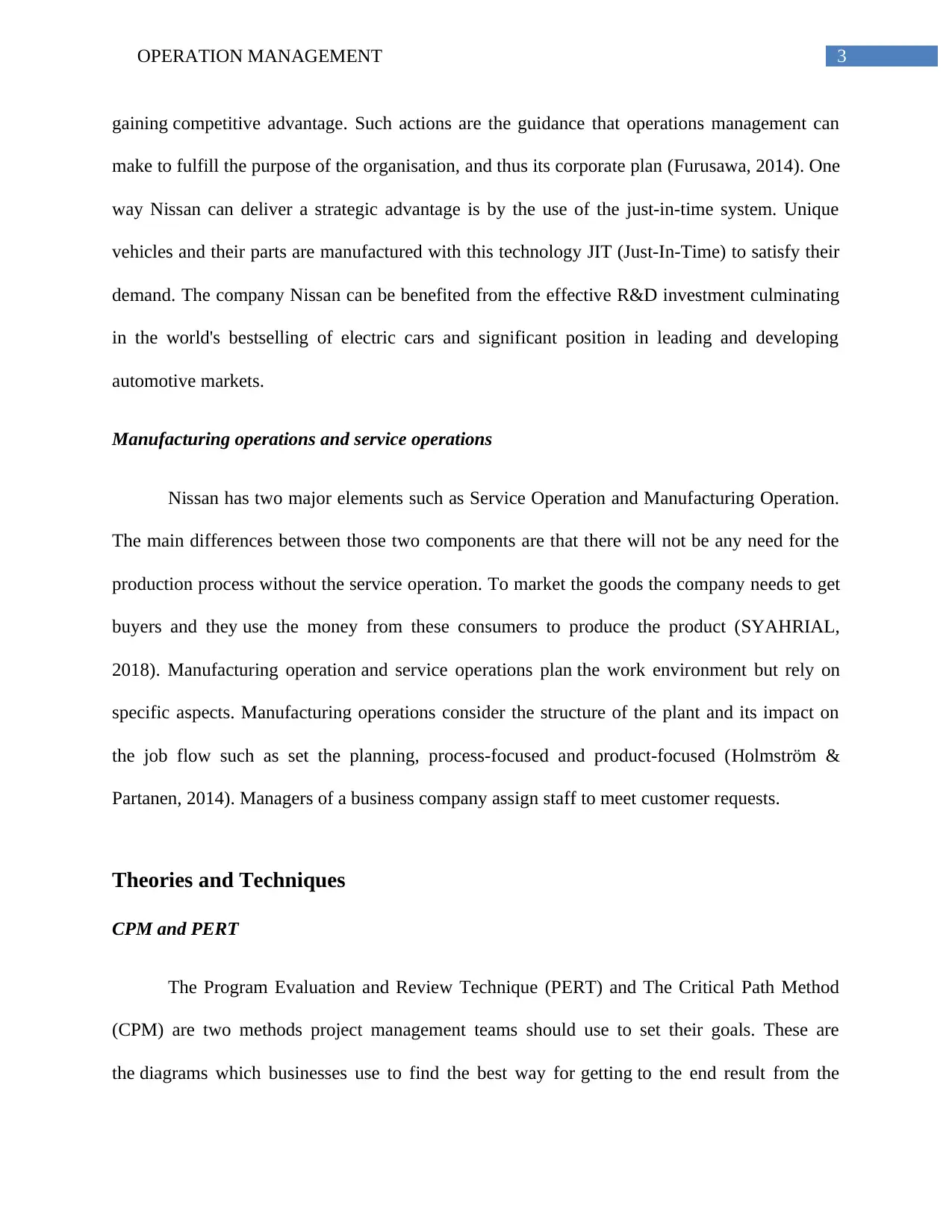
3OPERATION MANAGEMENT
gaining competitive advantage. Such actions are the guidance that operations management can
make to fulfill the purpose of the organisation, and thus its corporate plan (Furusawa, 2014). One
way Nissan can deliver a strategic advantage is by the use of the just-in-time system. Unique
vehicles and their parts are manufactured with this technology JIT (Just-In-Time) to satisfy their
demand. The company Nissan can be benefited from the effective R&D investment culminating
in the world's bestselling of electric cars and significant position in leading and developing
automotive markets.
Manufacturing operations and service operations
Nissan has two major elements such as Service Operation and Manufacturing Operation.
The main differences between those two components are that there will not be any need for the
production process without the service operation. To market the goods the company needs to get
buyers and they use the money from these consumers to produce the product (SYAHRIAL,
2018). Manufacturing operation and service operations plan the work environment but rely on
specific aspects. Manufacturing operations consider the structure of the plant and its impact on
the job flow such as set the planning, process-focused and product-focused (Holmström &
Partanen, 2014). Managers of a business company assign staff to meet customer requests.
Theories and Techniques
CPM and PERT
The Program Evaluation and Review Technique (PERT) and The Critical Path Method
(CPM) are two methods project management teams should use to set their goals. These are
the diagrams which businesses use to find the best way for getting to the end result from the
gaining competitive advantage. Such actions are the guidance that operations management can
make to fulfill the purpose of the organisation, and thus its corporate plan (Furusawa, 2014). One
way Nissan can deliver a strategic advantage is by the use of the just-in-time system. Unique
vehicles and their parts are manufactured with this technology JIT (Just-In-Time) to satisfy their
demand. The company Nissan can be benefited from the effective R&D investment culminating
in the world's bestselling of electric cars and significant position in leading and developing
automotive markets.
Manufacturing operations and service operations
Nissan has two major elements such as Service Operation and Manufacturing Operation.
The main differences between those two components are that there will not be any need for the
production process without the service operation. To market the goods the company needs to get
buyers and they use the money from these consumers to produce the product (SYAHRIAL,
2018). Manufacturing operation and service operations plan the work environment but rely on
specific aspects. Manufacturing operations consider the structure of the plant and its impact on
the job flow such as set the planning, process-focused and product-focused (Holmström &
Partanen, 2014). Managers of a business company assign staff to meet customer requests.
Theories and Techniques
CPM and PERT
The Program Evaluation and Review Technique (PERT) and The Critical Path Method
(CPM) are two methods project management teams should use to set their goals. These are
the diagrams which businesses use to find the best way for getting to the end result from the
Paraphrase This Document
Need a fresh take? Get an instant paraphrase of this document with our AI Paraphraser
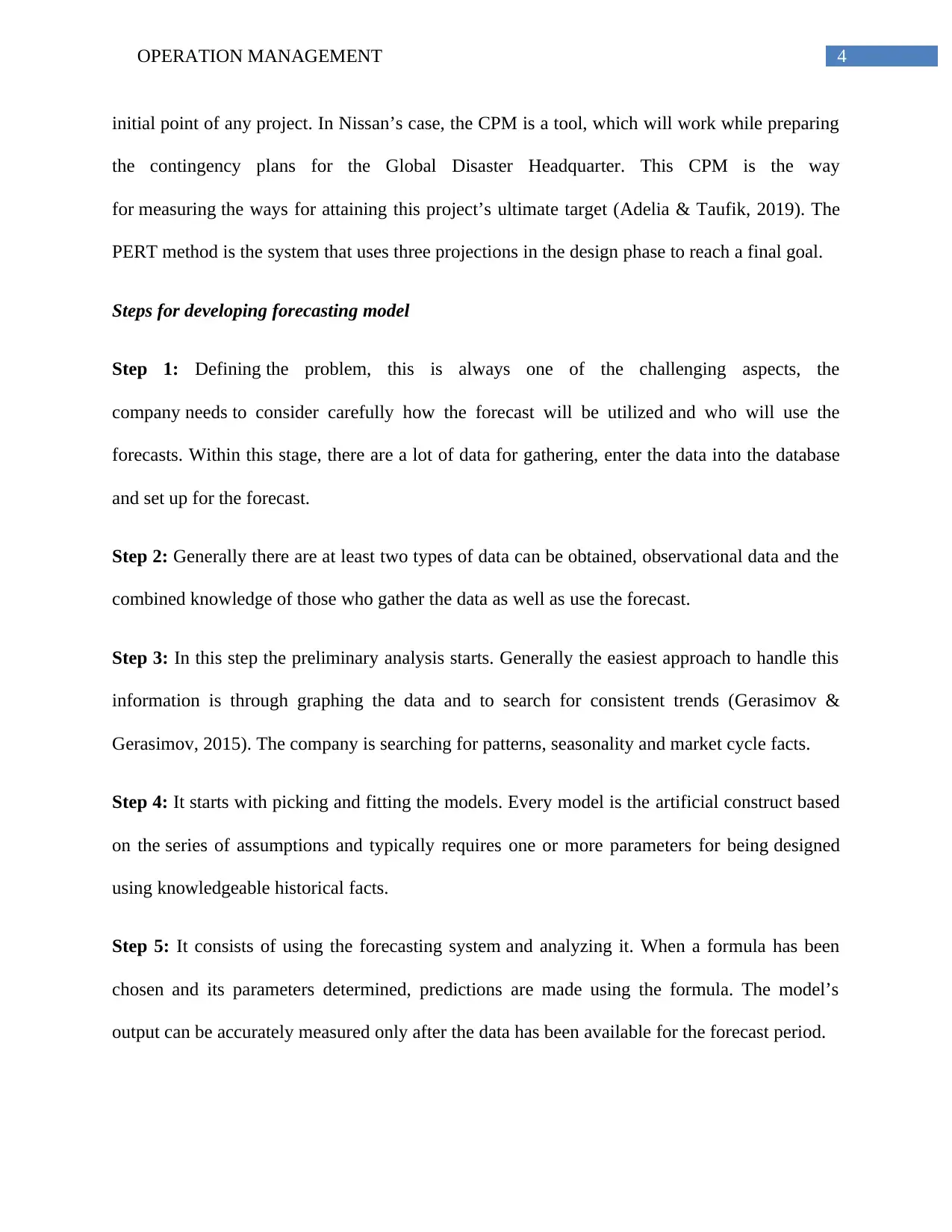
4OPERATION MANAGEMENT
initial point of any project. In Nissan’s case, the CPM is a tool, which will work while preparing
the contingency plans for the Global Disaster Headquarter. This CPM is the way
for measuring the ways for attaining this project’s ultimate target (Adelia & Taufik, 2019). The
PERT method is the system that uses three projections in the design phase to reach a final goal.
Steps for developing forecasting model
Step 1: Defining the problem, this is always one of the challenging aspects, the
company needs to consider carefully how the forecast will be utilized and who will use the
forecasts. Within this stage, there are a lot of data for gathering, enter the data into the database
and set up for the forecast.
Step 2: Generally there are at least two types of data can be obtained, observational data and the
combined knowledge of those who gather the data as well as use the forecast.
Step 3: In this step the preliminary analysis starts. Generally the easiest approach to handle this
information is through graphing the data and to search for consistent trends (Gerasimov &
Gerasimov, 2015). The company is searching for patterns, seasonality and market cycle facts.
Step 4: It starts with picking and fitting the models. Every model is the artificial construct based
on the series of assumptions and typically requires one or more parameters for being designed
using knowledgeable historical facts.
Step 5: It consists of using the forecasting system and analyzing it. When a formula has been
chosen and its parameters determined, predictions are made using the formula. The model’s
output can be accurately measured only after the data has been available for the forecast period.
initial point of any project. In Nissan’s case, the CPM is a tool, which will work while preparing
the contingency plans for the Global Disaster Headquarter. This CPM is the way
for measuring the ways for attaining this project’s ultimate target (Adelia & Taufik, 2019). The
PERT method is the system that uses three projections in the design phase to reach a final goal.
Steps for developing forecasting model
Step 1: Defining the problem, this is always one of the challenging aspects, the
company needs to consider carefully how the forecast will be utilized and who will use the
forecasts. Within this stage, there are a lot of data for gathering, enter the data into the database
and set up for the forecast.
Step 2: Generally there are at least two types of data can be obtained, observational data and the
combined knowledge of those who gather the data as well as use the forecast.
Step 3: In this step the preliminary analysis starts. Generally the easiest approach to handle this
information is through graphing the data and to search for consistent trends (Gerasimov &
Gerasimov, 2015). The company is searching for patterns, seasonality and market cycle facts.
Step 4: It starts with picking and fitting the models. Every model is the artificial construct based
on the series of assumptions and typically requires one or more parameters for being designed
using knowledgeable historical facts.
Step 5: It consists of using the forecasting system and analyzing it. When a formula has been
chosen and its parameters determined, predictions are made using the formula. The model’s
output can be accurately measured only after the data has been available for the forecast period.
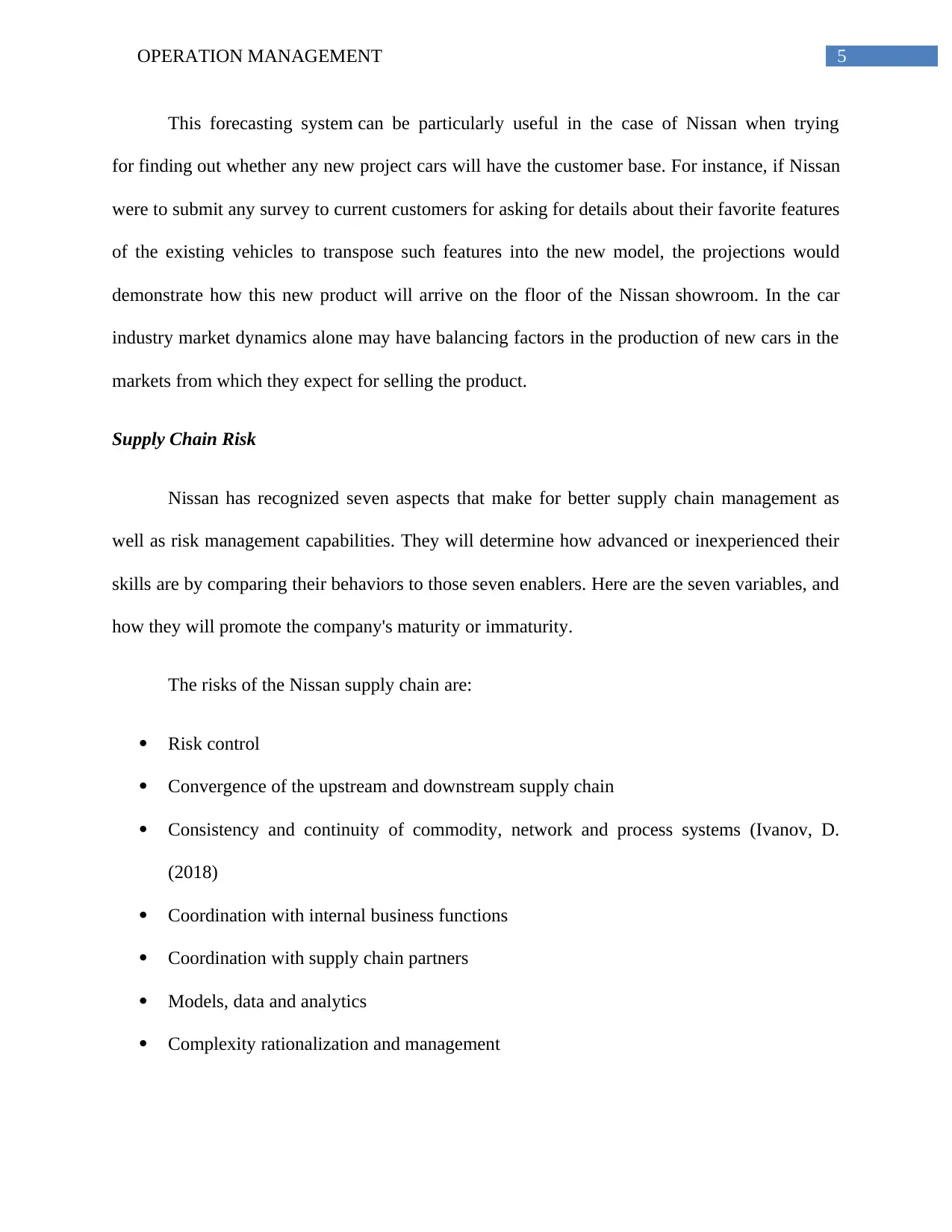
5OPERATION MANAGEMENT
This forecasting system can be particularly useful in the case of Nissan when trying
for finding out whether any new project cars will have the customer base. For instance, if Nissan
were to submit any survey to current customers for asking for details about their favorite features
of the existing vehicles to transpose such features into the new model, the projections would
demonstrate how this new product will arrive on the floor of the Nissan showroom. In the car
industry market dynamics alone may have balancing factors in the production of new cars in the
markets from which they expect for selling the product.
Supply Chain Risk
Nissan has recognized seven aspects that make for better supply chain management as
well as risk management capabilities. They will determine how advanced or inexperienced their
skills are by comparing their behaviors to those seven enablers. Here are the seven variables, and
how they will promote the company's maturity or immaturity.
The risks of the Nissan supply chain are:
Risk control
Convergence of the upstream and downstream supply chain
Consistency and continuity of commodity, network and process systems (Ivanov, D.
(2018)
Coordination with internal business functions
Coordination with supply chain partners
Models, data and analytics
Complexity rationalization and management
This forecasting system can be particularly useful in the case of Nissan when trying
for finding out whether any new project cars will have the customer base. For instance, if Nissan
were to submit any survey to current customers for asking for details about their favorite features
of the existing vehicles to transpose such features into the new model, the projections would
demonstrate how this new product will arrive on the floor of the Nissan showroom. In the car
industry market dynamics alone may have balancing factors in the production of new cars in the
markets from which they expect for selling the product.
Supply Chain Risk
Nissan has recognized seven aspects that make for better supply chain management as
well as risk management capabilities. They will determine how advanced or inexperienced their
skills are by comparing their behaviors to those seven enablers. Here are the seven variables, and
how they will promote the company's maturity or immaturity.
The risks of the Nissan supply chain are:
Risk control
Convergence of the upstream and downstream supply chain
Consistency and continuity of commodity, network and process systems (Ivanov, D.
(2018)
Coordination with internal business functions
Coordination with supply chain partners
Models, data and analytics
Complexity rationalization and management
⊘ This is a preview!⊘
Do you want full access?
Subscribe today to unlock all pages.

Trusted by 1+ million students worldwide
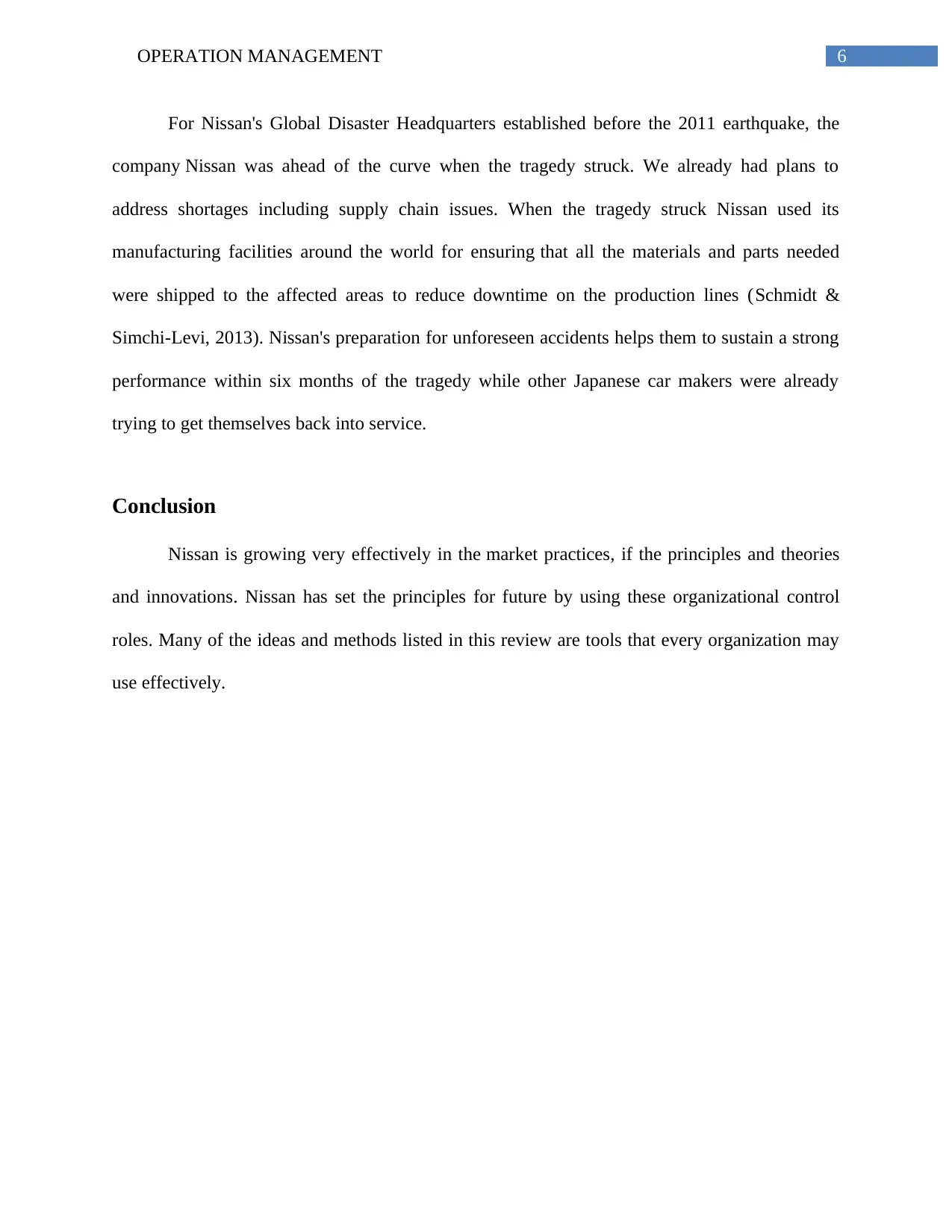
6OPERATION MANAGEMENT
For Nissan's Global Disaster Headquarters established before the 2011 earthquake, the
company Nissan was ahead of the curve when the tragedy struck. We already had plans to
address shortages including supply chain issues. When the tragedy struck Nissan used its
manufacturing facilities around the world for ensuring that all the materials and parts needed
were shipped to the affected areas to reduce downtime on the production lines (Schmidt &
Simchi-Levi, 2013). Nissan's preparation for unforeseen accidents helps them to sustain a strong
performance within six months of the tragedy while other Japanese car makers were already
trying to get themselves back into service.
Conclusion
Nissan is growing very effectively in the market practices, if the principles and theories
and innovations. Nissan has set the principles for future by using these organizational control
roles. Many of the ideas and methods listed in this review are tools that every organization may
use effectively.
For Nissan's Global Disaster Headquarters established before the 2011 earthquake, the
company Nissan was ahead of the curve when the tragedy struck. We already had plans to
address shortages including supply chain issues. When the tragedy struck Nissan used its
manufacturing facilities around the world for ensuring that all the materials and parts needed
were shipped to the affected areas to reduce downtime on the production lines (Schmidt &
Simchi-Levi, 2013). Nissan's preparation for unforeseen accidents helps them to sustain a strong
performance within six months of the tragedy while other Japanese car makers were already
trying to get themselves back into service.
Conclusion
Nissan is growing very effectively in the market practices, if the principles and theories
and innovations. Nissan has set the principles for future by using these organizational control
roles. Many of the ideas and methods listed in this review are tools that every organization may
use effectively.
Paraphrase This Document
Need a fresh take? Get an instant paraphrase of this document with our AI Paraphraser
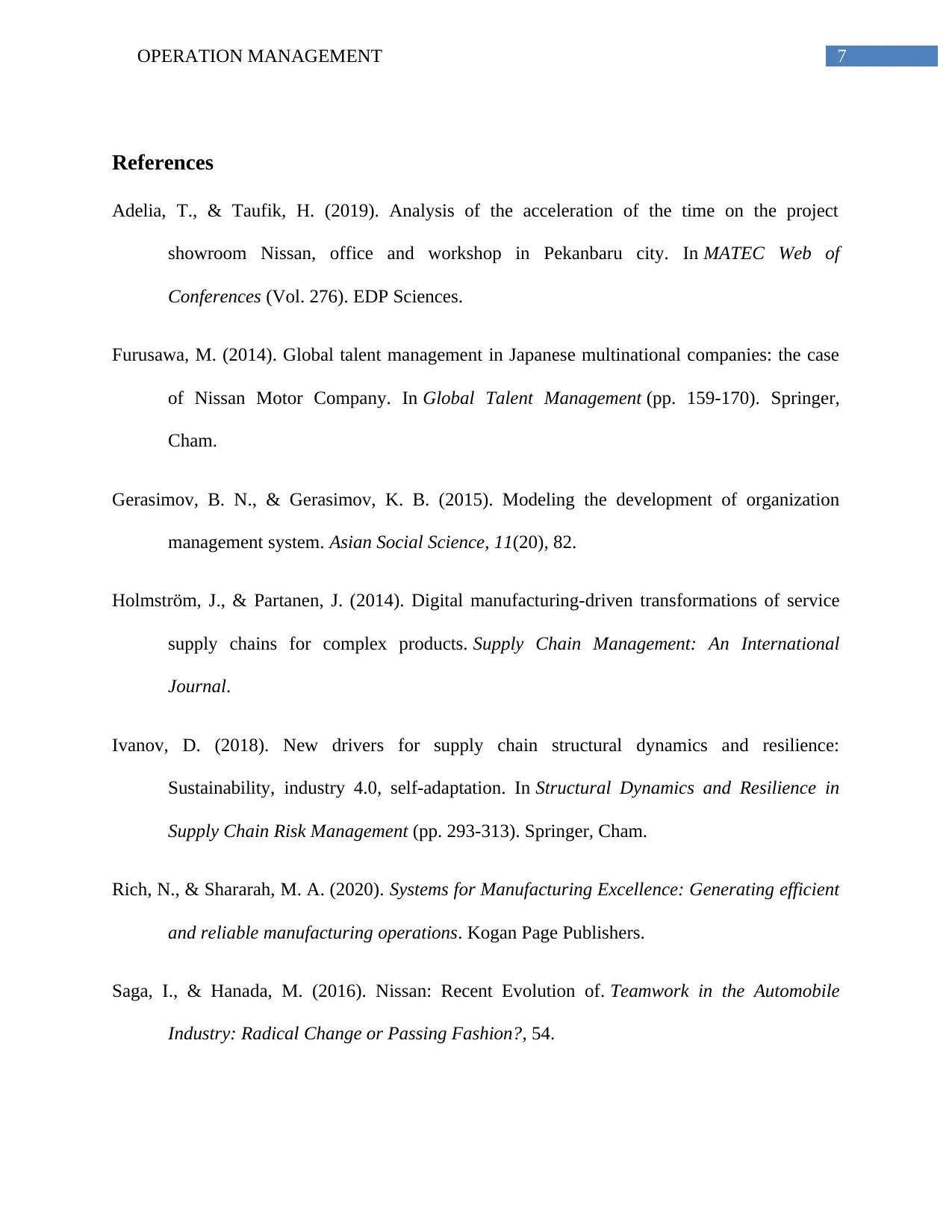
7OPERATION MANAGEMENT
References
Adelia, T., & Taufik, H. (2019). Analysis of the acceleration of the time on the project
showroom Nissan, office and workshop in Pekanbaru city. In MATEC Web of
Conferences (Vol. 276). EDP Sciences.
Furusawa, M. (2014). Global talent management in Japanese multinational companies: the case
of Nissan Motor Company. In Global Talent Management (pp. 159-170). Springer,
Cham.
Gerasimov, B. N., & Gerasimov, K. B. (2015). Modeling the development of organization
management system. Asian Social Science, 11(20), 82.
Holmström, J., & Partanen, J. (2014). Digital manufacturing-driven transformations of service
supply chains for complex products. Supply Chain Management: An International
Journal.
Ivanov, D. (2018). New drivers for supply chain structural dynamics and resilience:
Sustainability, industry 4.0, self-adaptation. In Structural Dynamics and Resilience in
Supply Chain Risk Management (pp. 293-313). Springer, Cham.
Rich, N., & Shararah, M. A. (2020). Systems for Manufacturing Excellence: Generating efficient
and reliable manufacturing operations. Kogan Page Publishers.
Saga, I., & Hanada, M. (2016). Nissan: Recent Evolution of. Teamwork in the Automobile
Industry: Radical Change or Passing Fashion?, 54.
References
Adelia, T., & Taufik, H. (2019). Analysis of the acceleration of the time on the project
showroom Nissan, office and workshop in Pekanbaru city. In MATEC Web of
Conferences (Vol. 276). EDP Sciences.
Furusawa, M. (2014). Global talent management in Japanese multinational companies: the case
of Nissan Motor Company. In Global Talent Management (pp. 159-170). Springer,
Cham.
Gerasimov, B. N., & Gerasimov, K. B. (2015). Modeling the development of organization
management system. Asian Social Science, 11(20), 82.
Holmström, J., & Partanen, J. (2014). Digital manufacturing-driven transformations of service
supply chains for complex products. Supply Chain Management: An International
Journal.
Ivanov, D. (2018). New drivers for supply chain structural dynamics and resilience:
Sustainability, industry 4.0, self-adaptation. In Structural Dynamics and Resilience in
Supply Chain Risk Management (pp. 293-313). Springer, Cham.
Rich, N., & Shararah, M. A. (2020). Systems for Manufacturing Excellence: Generating efficient
and reliable manufacturing operations. Kogan Page Publishers.
Saga, I., & Hanada, M. (2016). Nissan: Recent Evolution of. Teamwork in the Automobile
Industry: Radical Change or Passing Fashion?, 54.
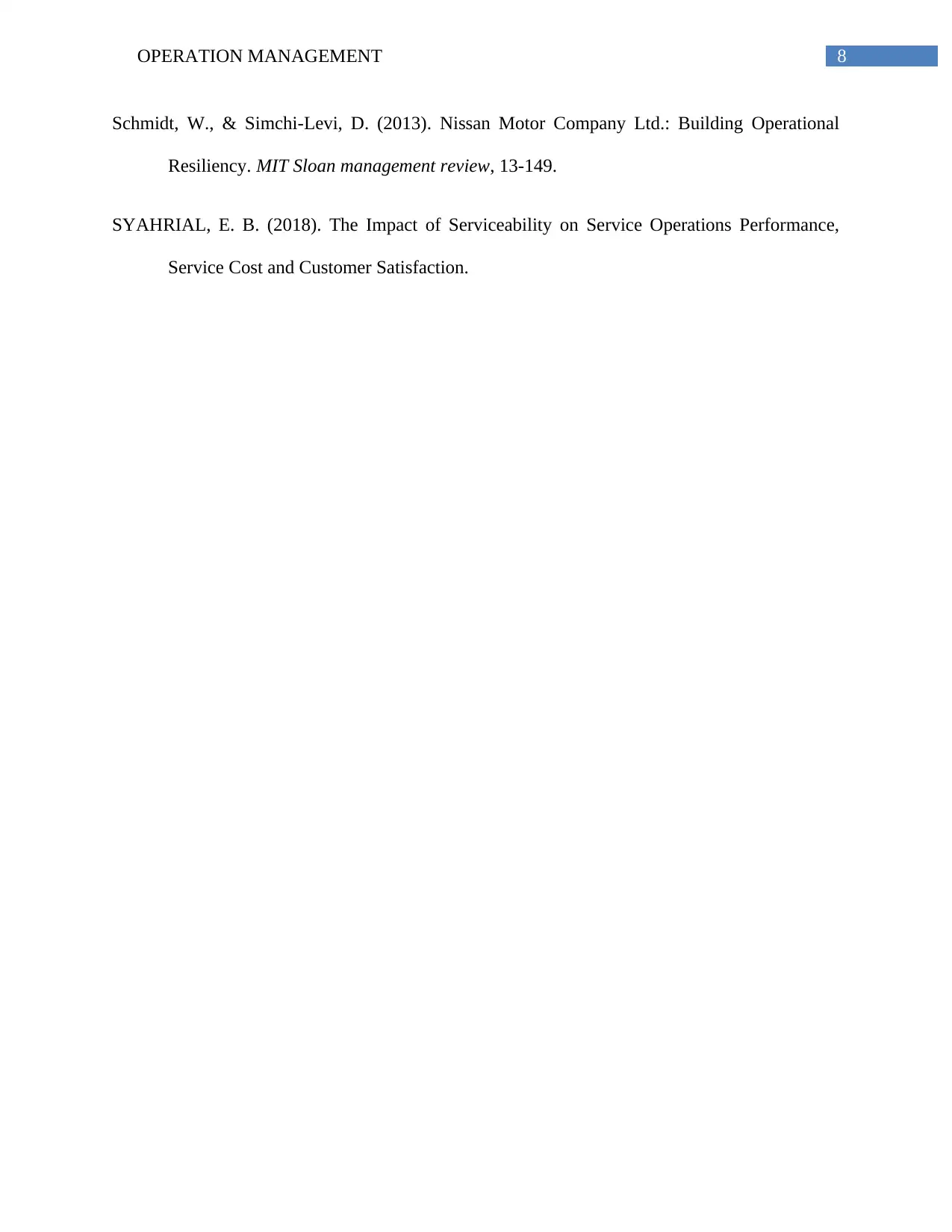
8OPERATION MANAGEMENT
Schmidt, W., & Simchi-Levi, D. (2013). Nissan Motor Company Ltd.: Building Operational
Resiliency. MIT Sloan management review, 13-149.
SYAHRIAL, E. B. (2018). The Impact of Serviceability on Service Operations Performance,
Service Cost and Customer Satisfaction.
Schmidt, W., & Simchi-Levi, D. (2013). Nissan Motor Company Ltd.: Building Operational
Resiliency. MIT Sloan management review, 13-149.
SYAHRIAL, E. B. (2018). The Impact of Serviceability on Service Operations Performance,
Service Cost and Customer Satisfaction.
⊘ This is a preview!⊘
Do you want full access?
Subscribe today to unlock all pages.

Trusted by 1+ million students worldwide
1 out of 9
Related Documents
Your All-in-One AI-Powered Toolkit for Academic Success.
+13062052269
info@desklib.com
Available 24*7 on WhatsApp / Email
![[object Object]](/_next/static/media/star-bottom.7253800d.svg)
Unlock your academic potential
Copyright © 2020–2025 A2Z Services. All Rights Reserved. Developed and managed by ZUCOL.





